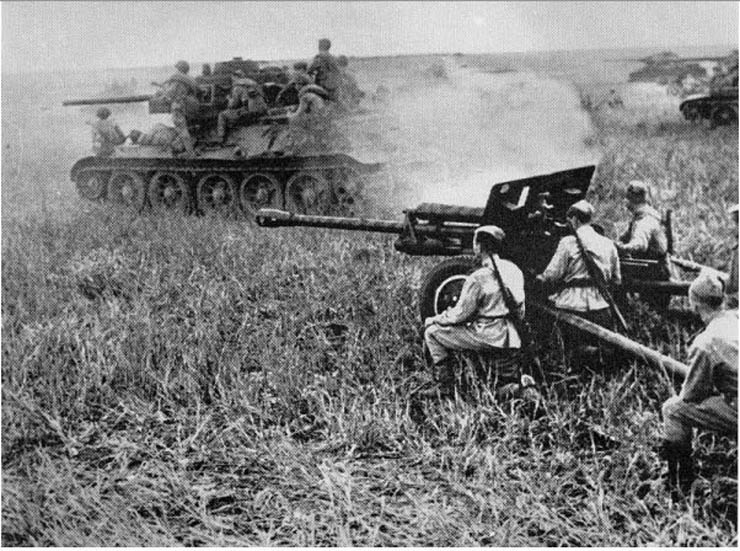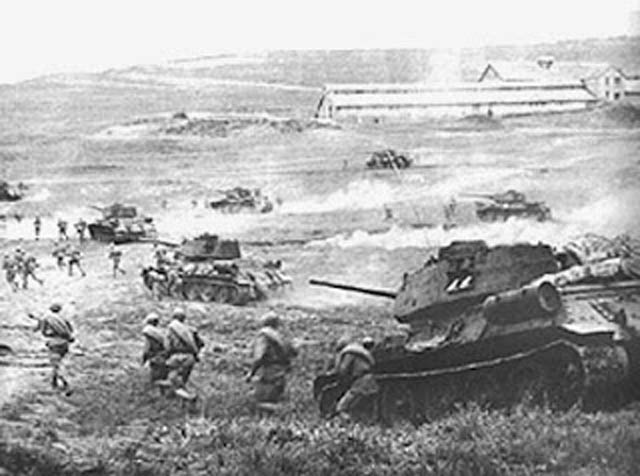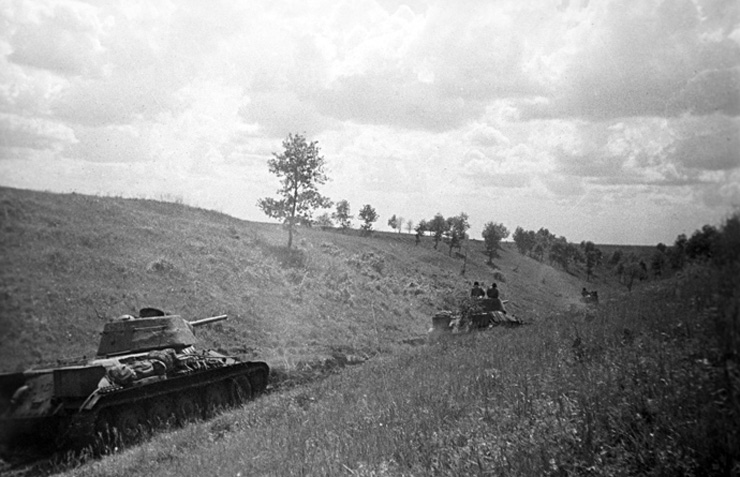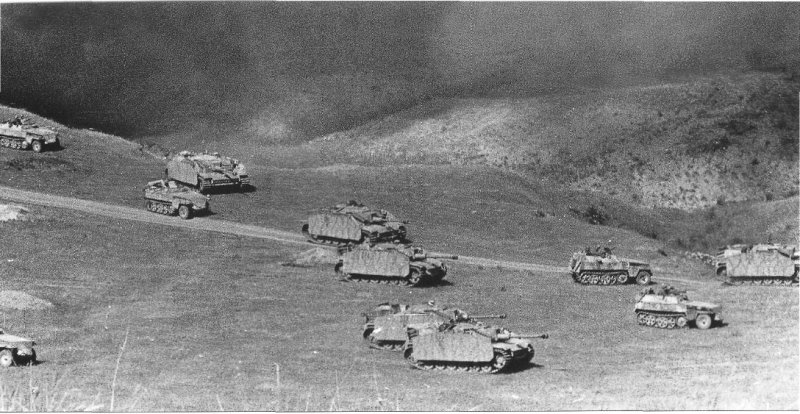Air Operations, Bismarcks
1 43rd Heavy Bomb Group B-17 attacks Garove Island and 5 V Bomber Command B-24s attack Rabaul and nearby airfields.
[Air Operations, CBI
CHINA- Flights of the the 14th Air Forceís new 21st Photographic-Reconnaissance Squadron, in F-4s and F-5s, mount their first missions of the war from bases at Kweilin and Kunming.
- 7 308th Heavy Bomb Group B-24s attack the port area at Campha, shipping at Ha Long Bay, and rail faicilities, warehouses, and a power plant at Hongay. Also, 23Rd Fighter Group P-40s strafe motor vehicles near Ha Giang.
Air Operations, East Indies
2 V Bomber Command B-25s attack several villages and the airfield at Lingat in the Molucca Islands.
[Air Operations, Europe
RAF BOMBER COMMANDEvening Ops:
- 295 Lancasters of Nos. 1, 5 and 8 Groups are sent to Turin.
- The main weight of this raid falls just north of the city center in clear weather. Among the RAF casualties on this night is Wing Commander J. D. Nettleton, Commanding Officer of 44 (Rhodesia) Squadron, who had won the Victoria Cross for the low-level daylight raid on Augsburg in April 1942. Nettleton's Lancaster is shot down by a German night fighter over the Channel while returning from Turin. He and his crew all die.
- 13 Lancasters are lost.
- 22 Wellingtons lay mines off Brest, Lorient and St Nazaire, and there are 19 OTU sorties.
- There are no losses.
ITALY:
IX Bomber Command B-24s attack the port facilities, ferry terminal, and marshalling yards at Reggio di Calabria, and the ferry terminal and rail yards at Villa San Giovanni.
[Air Operations, Sicily
- NASAF B-17s attack rail bridges around Messina.
- NASAF and NATAF B-25s, B-26s, and A-20s attack the Gerbini satellite fields, and the Agrigento, Canicatti, and Trapani/Milo Airdromes.
- NATAF A-20s and fighters attack the Trapani/Milo Airdrome and numerous rail and communication targets throughout the island.
- IX Bomber Command B-25s attack the Bo Rizzo Airdrome.
- Efforts by Axis aircraft to penetrate the Allies air cover over the fleet and the invasion beaches are virtually nil. Throughout the day 10 Axis fighters are downed in the area.
Air Operations, Solomons
- XIII Bomber Command B-24s attack the airfield at Ballale.
- 10 42nd Medium Bomb Group B-25s attack the Vila airfield on Kolombangara, which is also attacked later in the day by XIII Bomber Command B-24s on an armed reconnaissance mission.
- AirSols SBDs attack troop bivouacs and antiaircraft emplacements at Munda.
- 3 VMF-122 F4Us each down an A6M Zero over Rendova at 0815 hours.
- P-40s from the 18th Fighter Groupís 44th Fighter Squadron down 3 A6M Zeros over the Munda Point airfield on New Georgia between 0825 and 0830 hours.
- A 6th Night Fighter Squadron P-38 downs a G4M 'Betty' bomber over the Russell Islands at 2000 hours.
Battle of the Atlantic
- Liberator 'C of the 480th Group USAAF sinks the German submarine U-506 near Portugal.
- The US freigher African Star (6507t) is torpedoed and sunk by U-172 off the coast of Brazil with the loss of 1 Armed Guard sailor. The 56-man crew and 30 Armed Guard sailors are rescued the next day by the Brazilian destroyer Maranhao.
| Class | Type IXC |
| CO | Kapitänleutnant Erich Wuerdermann |
| Location | N Atlantic, W of Vigo |
| Cause | Air attack |
| Casualties | 54 |
| Survivors | 6 |
China
Chiang Kai-shek accepts the proposal put forward at the Trident Conference for a limited offensive, code-named SAUCY, to re-establish communications by land across Burma.
[Mediterranean
- U-409 is sunk by the British destroyer HMS Inconstant off Dellys on the Algerian coast. After making contact with the U-boat 6 depth charge attacks are made before the submarine surfaces and is then fired upon. The crew abandons her and she sinks.
- U-561 is torpedoed by MTB-81 in the Straits of Messina. It is the only occasion on which a U-boat is known to have been sunk by British coastal forces.
|
|
New Guinea
Allied forces advance on Mubo wiping out serveral Japanese strongholds.
[Pacific
- The Japanese submarine I-25 is sunk by the US destroyer Taylor (DD-468) in the Solomon Islands area.
- The US submarine Plunger (SS-179) sinks the Japanese merchant cargo ship Niitaka Maru (2478t) in the Sea of Japan west of Hokkaido.
Sicily
In the morning the Hermann Goering Div continues its attack on the American positions without success and, at 2:00p.m., is drawn off to face the more threatening British advance leaving a third of their tanks behind. The American 7th Army has reached its immediate objectives and is now digging in on the so-called 'yellow line' which starts from Palma di Montechiaro on the coast and passes throught Campobello, Mazzarino, Caltagirone and Grammichele. On the left of the American line the 3rd Div takes Canicatti. The 45th Div presses on beyond Comison and finally takes Chiaramonte Gulfi. All the airfields in this field of operations are firmly in Allied hands. The Americans have taken 18,000 prisoners and have lost about a thousand men killed and wounded. However, the Americans are now coming under increasing pressure from elements of 15th Pzrgrenadier Div which have been brought from the west of the island.
Wrecked German Aircraft |
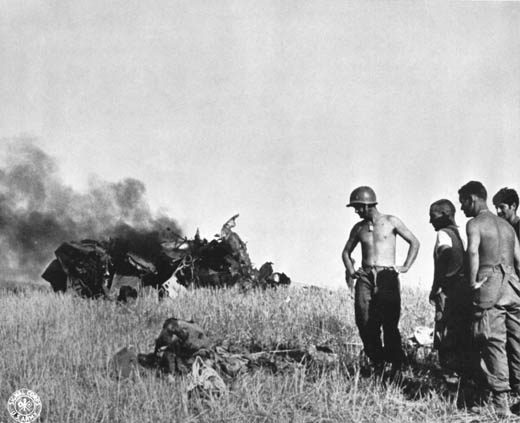 |
In the British sector of the front the 5th Div of the XIII Corps repulses attacks by the Schmalz Group and the Italian Napoli Div with the help of dive-bombers and support from naval guns, and advances on Augusta. Lentini is captured by the British 50th Div.
British and US forces join up at Ragusa. 6 airfields have been captured to this point.
[Solomons
In the battle for Munda, in New Georgia, the Americans make slight progress against the very resourceful enemy, but they are in severe difficulties with supplies.
During the night is the Naval Battle of Kolombangara. The 'Tokyo Night Express' bringing in 1,200 men to Kolombangara is intercepted in the Gulf of Kula, which is located between Kolombangara and New Georgia, by Adm Ainsworth's Task Force with 3 cruisers and 10 destroyers. The landing takes place while the Japanese escort to the 4 destroyers carrying the troops is already engaged with the enemy. The escort includes 1 cruiser and 5 destroyers led by Adm Shunji Izaki. There is a violent exchange of fire, and the Japanese fire a great many torpedoes. The American formation loses the destroyer Gwin (DD-433), while the cruisers St. Louis (CL-49), Honolulu (CL-48) and Leander, a New Zealand ship, are damaged by torpedoes. 2 other American destroyers, the Woodworth (DD-460) and the Buchanan (DD-484), are badly damaged as a result of a collision. However, the Japanese cruiser Jintsu is virtually blown out of the water by the radar-directed gunfire of the American cruisers. Going down with the ship is the commander Adm Izaki and 482 officers and ratings.
American Casualties Awaiting Evacuation |
 |
Soviet Union, Policy
The Soviets establish the National Committee for a Free Germany at the Krasnogorsk prisoner of war camp outside of Moscow. It consists of 38 members, 25 being soldiers and officers, including Field Marshal Paulus, and the remainder communist émigrés from Germany. The committee claims that the only hope for German survival is to remove Hitler and replace him with a new government with which the Allies might enter into peace negotiations.
[Eastern Front
In the Battle of Kursk the 4th Pzr Army, led by the II Pzr Corps, makes one final effort in the direction of Prokhorovka but cannot break through the fresh Soviet forces. Army Group South is now being threatened near Taganrog and Stalino, and in the north of the salient a huge Soviet counteroffensive begins toward Orel even as von Kluge orders Model to withdraw some of his panzers to meet such a threat. At the end of the day Hitler orders that the battle be discontinued. This new Soviet attack involves the 8 armies of the Central Front which is under Constantin Rokossovsky, the Bryansk Front under Markian Popov, and the Western Front under Vasily Sokolovsky. The attack is made in two thrusts, west from Novosil and south from between Kozelsk and Sukhinichi.
In this battle the Germans have conceded the strategic initiative to the Soviets for good. Their shortage of manpower has compelled them to attack on a limited front and to commit almost all of their tank force to one effort. The Soviet losses in the battle so far have probably been rather greater than the German's but they can afford it. The Luftwaffe losses have been severe and its dominance is now over. The Germans must also send troops to Italy but Hitler still forbids his Generals to make necessary withdrawals.
CENTRAL SECTORTo stop the Germans breaking through to Kursk in the south, Vatutin has been ordered to attack with the 1st Aank, 6th Guards, 5th Guards Tank and 5th Guards Armies against the mose immediate German threat. Hausser's II SS Panzer Corps and Knobelsdorff's XLVIII Panzer Corps. In addition, 7th Guards Army's XL Rifle Corps is ordered to strike the right flank of Army Detachment Kempf east of Razumnoe to prevent III Panzer Corps from kaing progress in its drive to link up with Haussers' men. The 500 tanks and assault guns of the 5th Guards Tank Army attack at 8:30am, driving back the panzers fo the Leibstandarte toward Oktiabr'skii. By the end of the day the Leibstandarte will have destroyed 192 Soviet tanks and 19 anti-tank guns for the loss of only 30 tanks. At 8:30am, 120 tanks of the II Guards Tank Corps went into the attack, preventing Das Reich from supporting the Leibstandarte's assault on Prokhorovka and from defending the Leibstandarte's right flank. South of the Psel River, with 121 tanks and assault guns, the Totenkopf has, by midday, captured Hill 226, greatly weakening Rotmistrov's right flank. But is is unable to advance farther than Poleshaev.
As the tank battles rage around Prokhorovka, the German situation to the west is deteriorating. With the XLVIII Panzer Corps poised to cross the Psel River and push on to Oboyan, yet another of Vatutin's spoiling attacks erupts agaisnt the 4th Panzer Army. Some 100 tanks of the XXII Guards Rifle Corps break through the German 332nd Infantry Div's positions, the V Guards Tank Corps (70 tanks) reaches Rakovo, and the X Tank Corps has driven the 3rd Panzer Div back toward Verkhopen'e and Berezovka. The 3rd Panzer Div (fewer than 50 tanks) needs assistance if the western flank of the entire southern pincer is not to collapse. Thus, the Grossdeutschland is redeployed to counter the threat. This isolates the 11th Panzer Div (50 tanks), which is attacked in the afternoon but to no effect.
The Soviet Operation KUTUZOV begins against the German Orel salient, conducted by the Bryansk Front (170,000 troops and more than 350 tanks and self-propelled guns), attacking the nose and southern flank of the salient, with the left wing of the Western Front (211,458 troops, 4,285 guns and mortars and 745 tanks and self-propelled guns) attacking along the northern flank of the salient. The 3rd Guards Tank Army, with 731 tanks and self-propelled guns, is held in reserve. Facing these forces is the 2nd Panzer Army (XXXV, LIII and LV Corps)
160,000 troops and 350 tanks and assault guns. The offensive opens at 3:30am, Soviet artillery battering the German lines until just after 6:00am. By the afternoon, the 11th Guards Army has pushed into the German lines, only to be held up by the 5th Panzer Div. Nevertheless, by nightfall the Soviets have forged 7 miles into the German lines.[MORE]
|
|
|
|
|
|
|
|
